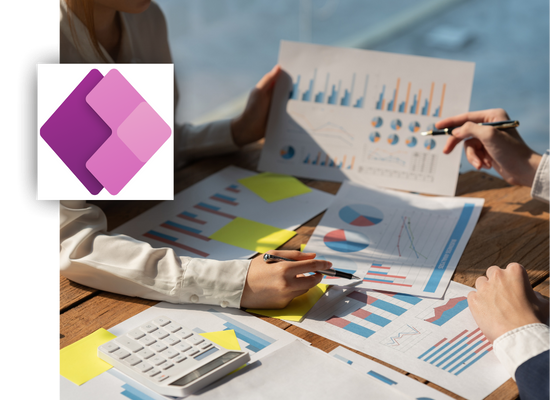In today’s fast-paced business environment, adaptability and efficiency are critical. Microsoft Power Apps, part of the Power Platform suite, empowers businesses to create custom applications that streamline operations, enhance productivity, and improve data accuracy—all without extensive coding knowledge.

Build functional apps quickly using drag-and-drop interfaces and prebuilt templates.
Empower non-developers to create apps while enabling developers to extend functionalities with Azure services.
Deliver apps that run seamlessly across devices—desktop, mobile, or tablets.
Connect with over 900 prebuilt connectors to integrate data from diverse sources, including Dynamics 365, SharePoint, and external databases.
Develop enterprise-grade applications with robust security, role-based access, and Azure-backed scalability.
50%App development time reduction
206% ROI on premium Power Apps over 3 years
<6 months payback time
Simplify complex workflows and automate routine tasks, reducing manual effort and errors.
Improve data quality with mobile applications designed for on-the-go data entry.
Avoid expensive software development cycles by deploying targeted apps for specific needs
Quickly deploy solutions to respond to emerging business challenges or opportunities.
At Alletec, we help organizations leverage Power Apps to create point solutions tailored to specific business needs. Whether it’s automating repetitive tasks, digitizing manual processes, or enabling accurate data capture, Power Apps ensures your workforce has the right tools at their fingertips.
Our expertise in Power Apps allows us to craft solutions that are not only functional but also intuitive and seamlessly integrated with your existing systems.

We work closely with your teams to identify areas where Power Apps can create significant impact.
From simple task automation to complex workflows, we design apps that meet your unique requirements.
Our solutions integrate effortlessly with Microsoft 365, Dynamics 365, Azure, and third-party systems to ensure a unified digital ecosystem.
Our ongoing support ensures your applications evolve with your business needs.
As a Microsoft Solutions Partner, Alletec combines technical excellence with industry expertise. Our commitment to being Agile, Affordable, and Accountable ensures that your Power Apps journey is seamless and impactful.
Ready to transform your business processes? Contact Alletec today to explore the possibilities with Power Apps.
The Power App portals were launched in October 2019, and since then this is the only type of portal available. The Dynamics 365 portals are also now referred to as Power Apps portals.
There are 2 licensing models possible for Power Apps. There is a 'Power Apps per App plan' which enables users full capabilities of Power Apps to run up to 2 apps (and one portal) for a specific business scenario. The current price for this plan is - US$10 (conversion rates applied in each country) per user, per app, per month. The other license model is 'Power Apps per user plan'. Users with this plan can run unlimited Apps. This plan currently has a cost of US$ 40 per user, per month.
Guests wanting to use an app must have same license types as a non-guest. These could be the per app, or per user plans, access rights included in Microsoft 365, or Dynamics 365. The one flexibility however is - this license may be assigned through either the tenant hosting the app being shared, or the home tenant of the guest user.
Power Apps are typically used to build multiple point solutions within an organization. These include several tasks that typically remain manual, despite the implementation of ERP and CRM systems. Power Apps give users the ability to quickly build applications to automate simple processes, connect to a vast number of data sources, digitalize the process at the point of data capture, integrate with Power Automate, Dynamics 365 and other applications to get the data to where it's needed. The Power Apps can be either Canvas apps, or Model Driven apps.